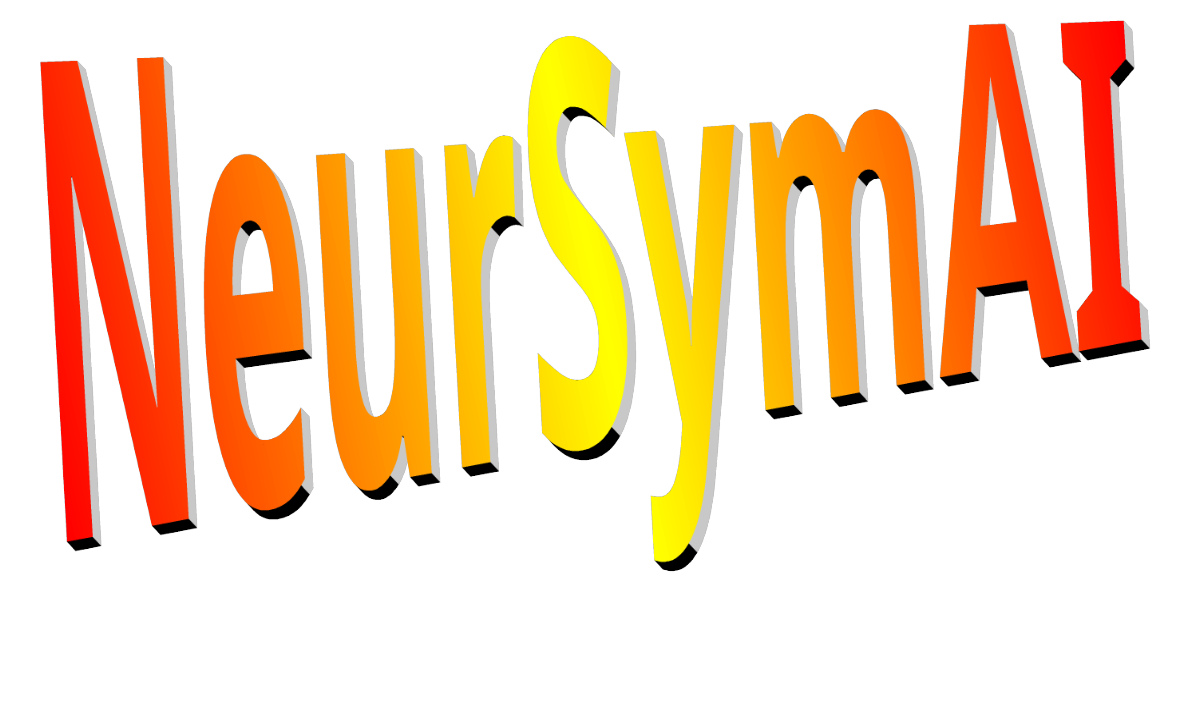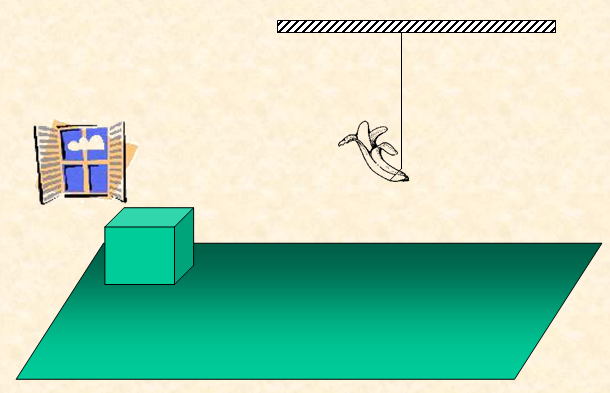
|
Telecom Paris
Dep. Informatique & Réseaux  Nils Holzenberger
← Home pageJanuary 2026
Nils Holzenberger
← Home pageJanuary 2026 |

 Logic, Knowledge Representation and Probabilities
Logic, Knowledge Representation and Probabilities
| with | Samuel Reyd |

|

Summary
Problem solving with Prolog
The monkey, the box and the banana

 The monkey must find a way to reach the banana which cannot be taken from the ground. She has a few actions at her disposal:
The monkey must find a way to reach the banana which cannot be taken from the ground. She has a few actions at her disposal:
- walk
- climb the box
- push the box
- grab the banana
action(InitialState, Action, ObtainedState)Each state is represented by a functor, the state functor, which has four arguments:
- horizontal position of the monkey
- vertical position of the monkey
- box position
- hand-banana connection.
% Definition of the possible actions with the state associated constraints
action(state(middle, onbox, middle, not_holding),
grab,
state(middle, onbox, middle, holding)).
action(state(P, floor, P, T),
climb,
state(P, onbox, P, T)).
action(state(P1, floor, P1, T),
push(P1, P2),
state(P2, floor, P2, T)).
action(state(P1, floor, B, T),
walk(P1, P2),
state(P2, floor, B, T)).Notice that giving the same name to two variables inside a same clause is meaningful: it imposes that the two variables are linked and have the same value. For instance, the climbing action action(state(P, floor, P, T), climb, ...) is possible only if the monkey and the box are located at the same place. However, the scope of a variable being limited to the clause, two variables having the same name but in two distinct clauses are not linked.Another important remark: state is a functor; a functor seems similar to a predicate, but it is the argument of a predicate or of another functor; some functors (especially the arithmetic functors such as +(3,2)) can be evaluated (try: ?- is(X,+(3,2)).).
% Definition of the success conditions in the problem of the monkey
success(state(_, _, _, holding)).
success(State1) :-
action(State1, A, State2),
write('Action : '), write(A), nl, write(' --> '), write(State2), nl,
success(State2).
(during unification, the sign "_" is a joker that can match anything; the nl predicate prints a ‘new line’ character). You may retrieve the program from ➜ there.Ask the interpreter:
?- success(state(door, floor, window, not_holding)).
Action : walk(door, _G582)
--> state(_G582, floor, window, not_holding)
Action : climb
--> state(window, onbox, window, not_holding)
Action : push(window, _G590)
--> state(_G590, floor, _G590, not_holding)
Action : climb
--> state(_G590, onbox, _G590, not_holding)
Action : grab
--> state(middle, onbox, middle, holding)The interpreter is able to search for actions that will lead it to success (notice the variable names invented by the interpreter, such as _G582). The behaviour of the monkey can be described as follows: it walks to the place where it can climb on the box. It finds itself on the box near the window, which leads to failure. It changes its mind and pushes the box from a place where it can be pushed (window) to another place. At the (not yet instantiated) new place, the monkey will climb on the box and grab the banana. This last place is eventually instantiated as being middle.Notice that the main part of the search is performed by the interpreter, and not by the developer who "only" entered possible actions and success conditions.
| Change the order of actions, for instance by putting the walk action first. What do you observe? |
| Instead of printing the monkey’s actions, we wish to store them into a list. You may use an additional argument Plan in the success predicate. Store actions into Plan once they have contributed to a successful state. Copy the clauses of the success predicate below (and those clauses only). |

The Tower of Hanoi (optional)
- (mention of the non-recursive solution)
- standard ad hoc recursive solution
- generic solution (similar to the monkey problem)
- without cycle detection
- with cycle detection
- width-first strategy
Accumulation
% bad solution (double recursion):
mirror([ ], [ ]).
mirror([X|L1], L2) :-
mirror(L1,L3),
append(L3, [X], L2). % append will dig into the list a second timeThis solution isn’t very clever, since to put X at the end of the list, append must go through the whole list anew. The following solution is more elegant. It makes use of the concept of accumulator. The accumulator (second argument in invert) is a list that gets filled during descent into recursion. Warning: recursion is amnesic when it returns up. In order not to loose the accumulator’s content, one has to save it. The third clause saves the accumulator into the third argument of invert. This argument is then dutifully copied during ascent, after each recursive call terminates (variable L3).
% better solution with accumulator:
mirror2(Left, Right) :-
invert(Left, [ ], Right).
invert([X|L1], L2, L3) :- % the list is 'poured'
invert(L1, [X|L2], L3). % into the second argument
invert([ ], L, L). % at the deepest level, the result L is merely copiedThe next exercise aims at checking whether a list is a palindrome. In French, "ressasser" and (ignoring spaces) "Esope reste ici et se repose" or "Engagez le jeu, que je le gagne!" are palindromes. In English, "rotator", "Too bad I hid a boot" or "No devil lived on" are palindromes. One of the most famous palindromes (and probably the longest one, as it has 1247 words!) has been written by George Perec. If you know of a funny palindrome, don’t hesitate to share it.
| Use mirror2 to write palindrome that checks whether a list is a palindrome. Then, think of a second version of palindrome using an accumulator. The point is to ‘pour’ the beginning of the list to check into the accumulator, and to sopt when the end of the list is equal to the accumulator’s content. With this solution, one goes through only half of the list. The remainder of the work is achieved by Prolog’s unification algorithm. |
You may retrieve a list of words of your favourite language from the Web, and then try to generate palindromes à la Perec. To do so, you’ll need to have a look at SWI-Prolog’s documentation (file reading, word to char list conversion, ...). Then, you’ll need to write a program that would judge the aesthetics of the generated palindrome. Well..., not that easy!
Knowledge representation
Using Prolog’s memory
’assert’ and ‘retract’
:- dynamic(sunshine/0). % necessary with SWI-Prolog.
:- dynamic(raining/0). % necessary with SWI-Prolog.
:- dynamic(fog/0). % necessary with SWI-Prolog.
nice :-
sunshine, not(raining).
funny :-
sunshine, raining.
disgusting :-
raining,fog.
raining.
fog.When executing a ‘directive’ like :- dynamic(pred/a)., SWI-Prolog knows that the predicate pred which has arity a (arity = number of arguments) can be modified dynamically (predicates are otherwise ‘compiled’ by SWI-Prolog and they can no longer be altered on the fly). Let’s execute our program:
?- nice.
no.
?- disgusting.
yes.
?- retract(fog).
yes.
?- disgusting.
no.
?- assert(sunshine).
yes.
?- funny.
yes.One may dynamically add clauses that are not mere facts.
?- assert((wet :- raining, not(umbrella))). % note the parentheses
yes.
?- wet.
yes.
?- assert(umbrella).
yes.
?- wet.
no.You may use Prolog’s memory to print them:
myprint :-
retract(item(X)), % reussit tant qu'il y a des items
write(X),nl,
fail.
myprint.This version erases items from memory. If this is problematic, the following version can be used:
myprint1 :-
retract(item(X)),
!, % avoids unwanted behahaviour if some predicate fails after a call to myprint1
myprint1,
write(X),nl,
asserta(item(X)). % asserta = version of assert that adds item on top of the memory stack
myprint1.Take one minute to think about the way this predicate works: myprint1 thoroughly empties memory by erasing items during the recursive descent, then retract fails (as there are no items left in memory), and this gives control to the second defining clause of myprint1; then the program climbs back from the bottom of recursion, writing and restoring items.Note that there are two additional standard versions of assert to control where the memorized item is placed in memory: asserta places the item on top of the stack and assertz at the bottom. SWI-Prolog considers assert and assertz as synonymous.
?- assert(a(1)). true. ?- assert(a(2)). true. 4 ?- a(X). X = 1 ; X = 2. |
?- asserta(b(1)). true. ?- asserta(b(2)). true. ?- b(X). X = 2 ; X = 1. |
?- assert(well_known(katy)), fail.
False.
?- well_known(X).
X = katy.The predicate retractall erases all matching items from memory. It always succeeds (even when there is no such item).
?- assert(well_known(katy)), retractall(well_known(_)).
true.
?- well_known(X).
false.
|
Use retract to write a predicate empty that behaves like retractall: it should erase all memorized facts about the predicate given as argument. Note that empty should always succeed.
Then try: assert(well_known(katy)). assert(well_known('Elvis')). assert(well_known(madonna)). assert(well_known(michael)). empty(well_known(_)). ?- well_known(X). false. |
The ‘findall’ predicate
?- findall(P, parent(P,_), ParentList).
ParentList = [marge, marge, marge, homer, homer, homer, abraham, abraham, mona|...].The variable may be decorated:
?- findall(p(P), parent(P,_), ParentList).
ParentList = [p(marge), p(marge), p(marge), p(homer), p(homer), p(homer), p(abraham), p(abraham), p(...)|...].We may use Prolog’s memory (with assert and retract) to write a predicate findany that mimics findall.
This predicate will be called the same way:
findany(Var, Pred, Results).
By executing Pred in the first place, the link (that is supposed to exist) betweeen Var and Pred gets instantiated.
The instantiated value of Var can be stored using assert; for instance: assert(found(Var)). Then, one can force backtracking by inserting fail.
Eventually, when Pred fails for good, it’s time to recover all memorized values and to put them into a list.
|
Write findany that mimics findall. findany(Var, Pred, Results).In a first clause, call Pred, then assert found(Var) and use fail to force backtracking. When Pred eventually fails, another predicate collect_found should gather results into a list. |
Semantic networks

% adapted from I. Bratko - "Prolog - Programming for Artificial Intelligence"
% Addison Wesley 1990
isa(bird, animal).
isa(albert, albatross).
isa(albatross, bird).
isa(kiwi, bird).
isa(willy, kiwi).
isa(crow, bird).
food(albatross,fish).
food(bird,grain).
locomotion(bird, fly).
locomotion(kiwi, walk). % kiwis don't fly, it seems Semantic networks are interesting in several respects. In their graphic form, they are easier to read than rules; they can be used to perform association (by propagating influences); The isa relation can be used to define inheritance.
locomotion(X, Loc) :- % inheritance rule
isa(X, SuperX),
locomotion(SuperX, Loc).This way of writing inheritance rules is not really smart. One needs a different inheritance rule for each relation! Thanks to Prolog, one can write a more general inheritance mechanism.
known(Fact) :-
Fact, % checks wether Prolog succeeds while executing Fact
!. % no need to seek further
known(Fact) :-
Fact =.. [Property, Concept, Value], % Fact is a foncteur, with the concept as first argument.
isa(Concept, ParentConcept), % getting the parent concept
SuperFact =.. [Property, ParentConcept, Value], % substituting for the parent concept
known(SuperFact). % This will instantiate ValueWe are using one of Prolog’s great syntactic features: the "=.." operator. This tool transforms functors into lists (or the converse). Very convenient to maipulate functors and predicates.
?- f(a,b) =.. [f, a, b].
true. The above program is available from ➜ there.
| Try the solution based on predicate known with the following exemple: ?- known(locomotion(albert, L)).What about the kiwi’s locomotion? |
?- known(locomotion(crow, M)), M = fly.
M = fly.
?- known(locomotion(kiwi, M)), M = fly.
false.(It would be possible to prevent such inappropriate use with a test like var(Value).)Non-monotonic reasoning consists in the fact that the set of inferred facts does not necessarily increase when knowledge is augmented. In other words, knowing more may lead to inferring less.
| Write a predicate habitat(Animal, Location) to express the fact that non-flying animals live on the continent.
The predicate may specify an unknown location by default. Since ostriches are birds, the question: known(habitat(ostrich, L)). should answer L = unknown.Add the piece of knowledge: asserta(locomotion(ostrich, run)). and verify that habitat(ostrich, L). now answers L = continent. |
Ontologies
Ontologies have always been a classic tool of artificial intelligence. They recently experienced a renewed interest in a much larger community concerned with the "Semantic Web".Some professional sectors are involved in the definition of ontologies of significant sizes (several thousand concepts). Visit for example Mikrokosmos, CYC, Wordnet, ConceptNet, DOLCE (general ontologies for natural language processing), Menelas (medical reports in coronary angiography), SNOMED-CT (medical ontology, 3.105 concepts), CAB (sciences), Dublin Core ontology (bibliography). You may like to compare the top concepts of ontologies like Mikrokosmos, DOLCE, ConceptNet and CYC.The construction of ontologies is often achieved by human operators (which presupposes considerable investments). Some tools exist to facilitate the task. One of the best known in the world of research is Protégé, developed at Stanford University. We may also mention DOE (Differential Ontology Editor), OntoLingua (also at Stanford), HOZO (Osaka University). One of the primary objectives of ontology development is to facilitate disambiguation, to make inferences, and ultimately to allow the development of search engines based on meaning (and not just on words). See for example the engine CORESE (developed at INRIA). It is therefore essential that the structure associated with a concept be easily accessible, if possible in a standardized mode. The W3C (www consortium) proposes standards based on markup languages (built on XML), such as RDF or OWL (Web Ontology Language).If all the semantic resources were described according to the same ontology, developing intelligent search engines would be relatively easy. However, such global standardization is impossible because of the variety of subject areas and the arbitrary nature of certain choices, and is unlikely to be desirable for many other reasons. We must therefore imagine systems that are able to align ontologies automatically. The task is however not easy.
The main hope, both for standardization and for matching ontologies, but also for their use in reasoning, lies in the use of logic, and in particular in the development of description logics.
Description logics
Mother = Woman ⊓ hasChild.Person
(⊓ designates conjunction) translastes into logic as:
Mother(x) ≡ Woman(x) ∧ (∃y) (hasChild(x, y) ∧ Person(y))More generally, here is the translation into predicate logic of expressions involving quantifiers:
∃r.C = (∃y) (r(x, y) ∧ C(y))
∀r.C = (∀y) (r(x, y) ⊃ C(y))
A family ontology:
woman ≐ person ⊓ female
man ≐ person ⊓ ¬ female
mother ≐ woman ⊓ ∃ child.person
father ≐ man ⊓ ∃ child.person
parent ≐ person ⊓ ∃ child.person or: parent ≐ mother ⊔ father
grandmother ≐ mother ⊓ ∃ child.parent
motherWithoutDaughter ≐ mother ⊓ ∀ child.¬female
spouse ≐ woman ⊓ ∃ married_to.man
monogamousSpouse ≐ woman ⊓ ∃ married_to.man ⊓ (< married_to 1)(⊔ designates disjunction and ¬ designates negation).A knowledge base in description logic includes:
- a terminology, called T-box,
- a set of facts or assertions, called A-box.
daughterlesswoman(Paulette)
child(Paulette, Pierre)
child(Paulette, Jacques)
father(Pierre)
child(Pierre, Marinette)It is easy to see that a knowledge base might be inconsistent. The strength of description logics is to be able to demonstrate the coherence (and therefore the satisfiability) of a given knowledge base.Description logics (as a matter of fact, there are several) differ by the logical connectors they allow. The
 language
Includes negation of atomic concepts, conjunction, universal quantifier ∀, and a restriction of the existential quantifier ∃ such as: ∃ child.
language
Includes negation of atomic concepts, conjunction, universal quantifier ∀, and a restriction of the existential quantifier ∃ such as: ∃ child. (
( designates tautology, so ∃ child.
designates tautology, so ∃ child. means that the individual has a child, but is it not possible to add any further restriction on the existing child). The
means that the individual has a child, but is it not possible to add any further restriction on the existing child). The  language can be augmented to include full existential quantification, union, predication on cardinality, negation of complex concepts, hierarchy of relations (sort of second order predication), enumeration of possible values, and do on. Conversely, it is possible to remove negation and existential quantification. For example, the ontologies editor Protégé supports the negation of complex concepts, the hierarchy of relations, enumerations and cardinality.The simplest description logics, such as
language can be augmented to include full existential quantification, union, predication on cardinality, negation of complex concepts, hierarchy of relations (sort of second order predication), enumeration of possible values, and do on. Conversely, it is possible to remove negation and existential quantification. For example, the ontologies editor Protégé supports the negation of complex concepts, the hierarchy of relations, enumerations and cardinality.The simplest description logics, such as  without negation and existential quantification, have the advantage of offering satisfiability test that is decidable in polynomial time. Decidability becomes exponential for more complex formalisms. For a first-order logical formalism, there is only semi-decidability (one is assured to prove satisfiability in a finite time if the formula is satisfiable, but one can loop for ever if the formula is not satisfiable).
without negation and existential quantification, have the advantage of offering satisfiability test that is decidable in polynomial time. Decidability becomes exponential for more complex formalisms. For a first-order logical formalism, there is only semi-decidability (one is assured to prove satisfiability in a finite time if the formula is satisfiable, but one can loop for ever if the formula is not satisfiable).| Based on the examples above, define the concept of aunt (let’s assume that the sister relationship is available).
(you may replace symbols with appropriate words such as ‘exist’ and ‘and-square'). |
 . It is therefore not possible to deduce the sister relationship from the child relationship, as would be done in Prolog. Description logics have a certain power of expression which is just sufficient to represent terminological knowledge, and their limitations are necessary to make effective reasoning possible. They don’t, however, have the description and inference power of the predicate logic.
. It is therefore not possible to deduce the sister relationship from the child relationship, as would be done in Prolog. Description logics have a certain power of expression which is just sufficient to represent terminological knowledge, and their limitations are necessary to make effective reasoning possible. They don’t, however, have the description and inference power of the predicate logic.
Reading suggestions:
 Back to the main page
Back to the main page